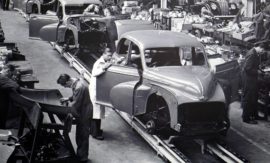Intended learning outcomes: Explain different archetypes in engineer-to-order: basic, repeatable, complex, non-competitive ETO.
In the plant manufacturing industry, many areas of a plant facility are customer specific and produced in nonrepetitive production. With an intelligent product concept, however, it is usually possible to determine similarities of the plant facility to previously produced plants. For instance, during processing of an order, the vendor recalls previous “similar” problems. Derivation can thus often be performed on the basis of a previous customer order as a “parent version,” using adaptive techniques according to Section 7.2, at worst position by position. Such orders generally require a high degree of order-specific engineering. They have to be developed and built to exactly match the customer's specifications. Other examples of this classic situation would be customer-specific modernization of an aircraft, an oil platform, or a nuclear power plant. If there are very many bill-of-material and routing-sheet positions, this will entail a high load on qualified employees. In addition, the lead time is long. Either is only justified for high-value-added products.
In the plant manufacturing industry, there have been attempts to restrict order specific engineering to a minimum and to use generative techniques for the larger part of the customer order (also see Section 7.3). This has worked well in the exterior construction business; for example, where certain elements of building exteriors are selected from a preset range of variants. Combining the elements for the whole face of a building, however, may well require order specific engineering. Except in the area of project management, or general procedures, this minimum level of ETO offers little or no potential for standardization and automation. The consequence is a low degree of industrialization. As well as this classic case of engineer-to-order, there are also situations where a higher degree of industrialization is necessary (and also possible) for reasons of cost or throughput time. The Portfolio in Figure 7.4.1.1 shows different archetypes of engineer-to-order (ETO).
Figure 7.4.1.1 Different archetypes in engineer-to-order (compare [WiPo15]).
The “Annual units sold” dimension shows how many units of a product family are sold on average per year. A unit is generally the lot that is ordered as one order unit and therefore manufactured in this lot size. Often, lot size one (batch size one) is essential; then, the units sold are the pieces sold. The threshold of 750 units/year is based on the assumption that making at least two units/day offers a sufficiently high degree of repetition for cost-effective automation.
The “Engineering Complexity” dimension measures the number of necessary engineering hours per unit sold. In practice, order-specific engineering is one of the biggest drivers of complexity in the ETO environment. Consequently, the possible benefit of an automation depends on it. The boundary between the quadrants has been set at 2000 engineering hours/unit, as that corresponds to one person year.
The classic “engineer-to-order” situation described above is called “Complex ETO” in Figure 7.4.1.1. Only a small degree of industrialization is possible, since the repeat rate is very low at both the product and the process levels. “Non-competitive ETO” relates to firms that deploy over 750 full-time positions for customer-specific engineering (≥ 750 units/year times ≥ 2000 h per unit). For firms of this size, it was previously possible to combine them as a conglomerate of subsidiaries, with each company supplying less than 750 order items per year. The subsidiaries can therefore be included in the “Complex ETO.” We suspect that it is not profitable over the long term for a company to position itself in this quadrant, unless it has a monopoly and the company is therefore not exposed to competition. The two others, “Basic ETO” and “Repeatable ETO,” are covered in the next two sections.
Course section 7.4: Subsections and their intended learning outcomes

7.4 Generative and Adaptive Techniques for Engineer-to-Order (ETO)
Intended learning outcomes: Differentiate between the classical procedure and different archetypes of engineer-to-order. Describe the approach for basic and for repeatable engineer-to-order.

7.4.1 Classical Procedure and Different Archetypes of Engineer-to-Order (ETO)
Intended learning outcomes: Explain different archetypes in engineer-to-order: basic, repeatable, complex, non-competitive ETO.

7.4.2 Approach for Basic Engineer-to-Order
Intended learning outcomes: Explain the template for bill of material and routing sheet used to work out similar variants.

7.4.3 Approach for Repeatable Engineer-to-Order
Intended learning outcomes: Describe a typical engineer-to-order business process and its permanent enabling process. Explain role of the permanent engineer-to-order enabling process.
